You are about to embark on an adventure of a lifetime, the Annapurna Base Camp Trek in February. Imagine yourself standing at the foothills of the magnificent Himalayas, surrounded by towering snow-capped peaks that seem to touch the sky. The air is crisp and cold, and every breath you take fills your lungs with the purest mountain air.
During your journey, you will encounter some of the most stunning natural environments including lush forests, rapid rivers, and serene lakes. You will also have the opportunity to explore isolated communities and discover their distinctive customs and ways of life.
Location and Altitude
Annapurna Base Camp is a popular trekking destination located in the Annapurna region of Nepal. It is situated at an altitude of 4,130 meters (13,549 feet) above sea level and it is surrounded by some of the world’s highest peaks, including Annapurna South (7,219 m/ 23,684 ft), Hiunchuli (6,441 m/ 21,132 ft), and Machhapuchhre (6,993 m/ 22,943 ft).
Weather Conditions of ABC in February
The weather conditions at Annapurna Base Camp in February can be quite unpredictable and challenging due to the cold and dry winter season. At this time of the year, the temperature at the base camp can range from -10°C to 10°C with an average of around -5°C.
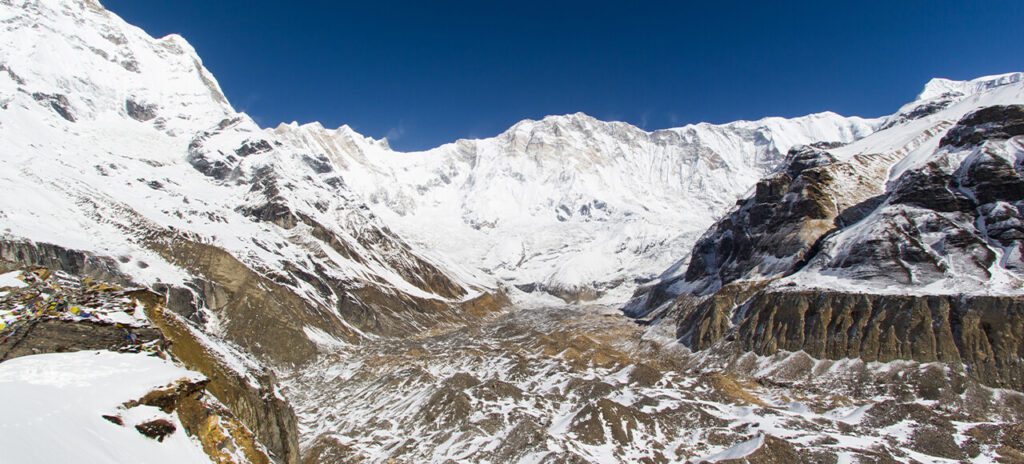
February is considered the coldest month of the year at ABC, and it’s not uncommon for temperatures to drop well below freezing at night. During the daytime, the sun can be quite strong and provide some warmth but the cold winds can still make it feel quite chilly.
In February, snowfall is also extremely frequent which might make the climb to ABC more difficult. It’s important to have the right equipment and apparel to guard against the cold and snowy weather since the snow may make the paths slick and more difficult to approach.
Kathmandu to Annapurna Base Camp
The Annapurna Base Camp (ABC) trek is a popular trekking destination in Nepal. It takes about 7-12 days to complete the trek, depending on your pace and the route you choose. Here’s how you can get to Annapurna Base Camp from Kathmandu:
- By Flight: The quickest way to get to Pokhara, the starting point of the Annapurna Base Camp trek is by taking a 25 minutes flight from Kathmandu to Pokhara. From Pokhara, you can take a private jeep or a local bus to Nayapul which is also the starting point of the trek.
- By Bus: An alternative mode of transportation is a tourist bus that covers the distance between Kathmandu and Pokhara in approximately 7 to 8 hours. From Pokhara to Nayapul, you can choose to take a local bus or a private vehicle.
- Private Car: You can also hire a private car or jeep from Kathmandu to Pokhara which takes around 6 to 7 hours. From Pokhara, you can take a private jeep or a local bus to Nayapul.
Trails of Annapurna Base Camp
The trek takes you through a variety of landscapes, from lush forests to barren high-altitude terrain, and offers a chance to experience the local culture of the region. Here’s a brief overview of the trails you can expect to encounter during the Annapurna Base Camp Trek:
Pokhara to Nayapul:
The trek begins in Pokhara, which is the starting point for many treks in the Annapurna region. From there, you’ll take a jeep or bus to Nayapul, which is the official starting point of the trek.
Nayapul to Tikhedhunga:
From Nayapul, you’ll begin your trek towards Tikhedhunga which is a small village located on the banks of the Bhurungdi Khola River. The trail takes you through rice paddies and small villages.
Tikhedhunga to Ghorepani:
The trail from Tikhedhunga to Ghorepani is steep and can be challenging, but the views are well worth the effort.
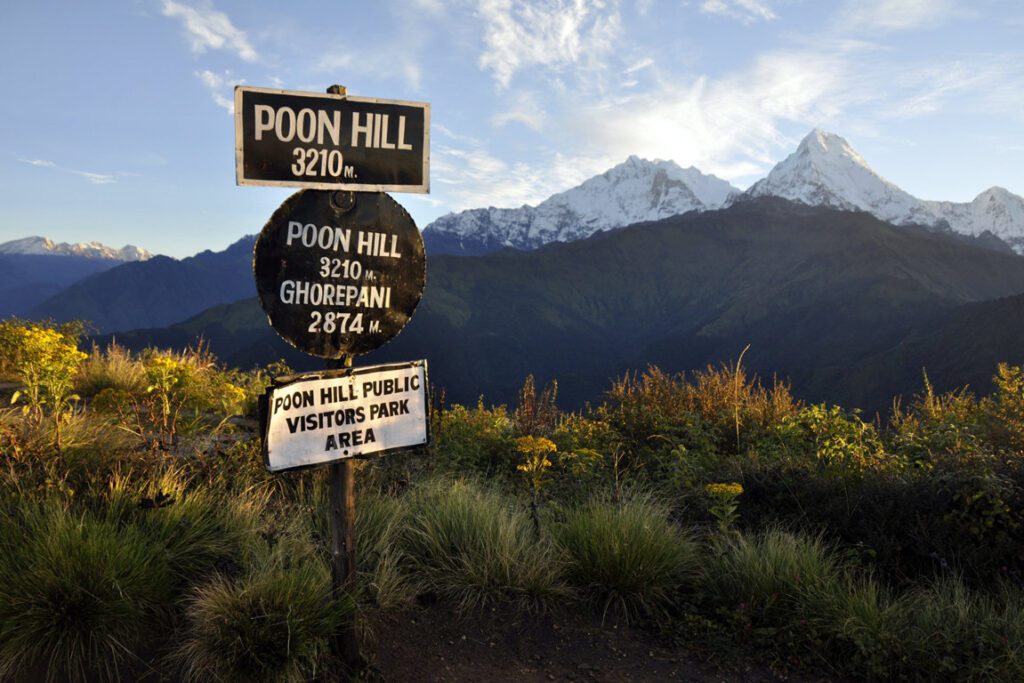
Ghorepani is a popular stopover point and offers stunning views of the surrounding mountains.
Ghorepani to Tadapani:
From Ghorepani, you’ll trek through rhododendron forests toward Tadapani.
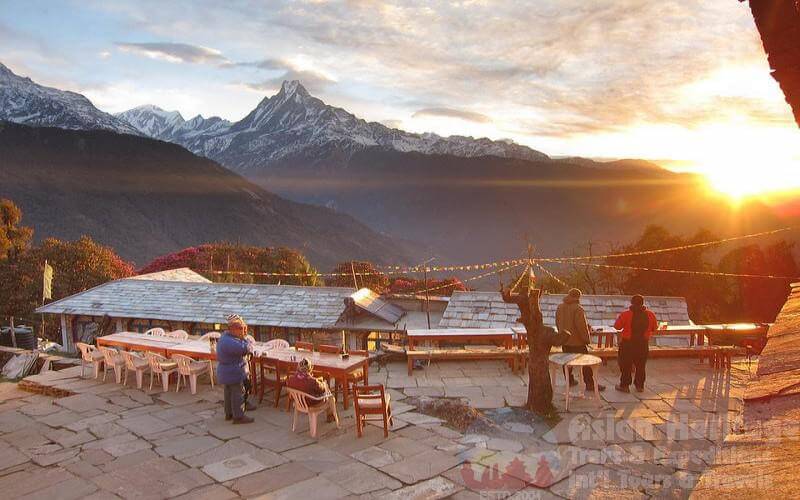
Along the way, you’ll have the opportunity to visit Poon Hill, which offers breathtaking sunrise views over the Himalayas.
Also Read: Annapurna Base Camp in January
Tadapani to Chomrong:
The trail from Tadapani to Chomrong takes you through dense forests and small villages. Chomrong is the last permanent settlement before reaching the base camp.
Chomrong to Dovan:
From Chomrong, you’ll descend to the Modi Khola River and cross a suspension bridge. The trail then ascends through bamboo forests towards Dovan.
Dovan to Machhapuchhre Base Camp:
The trail from Dovan to the Machhapuchhre Base Camp takes you through rocky terrain and offers stunning views of the surrounding mountains.
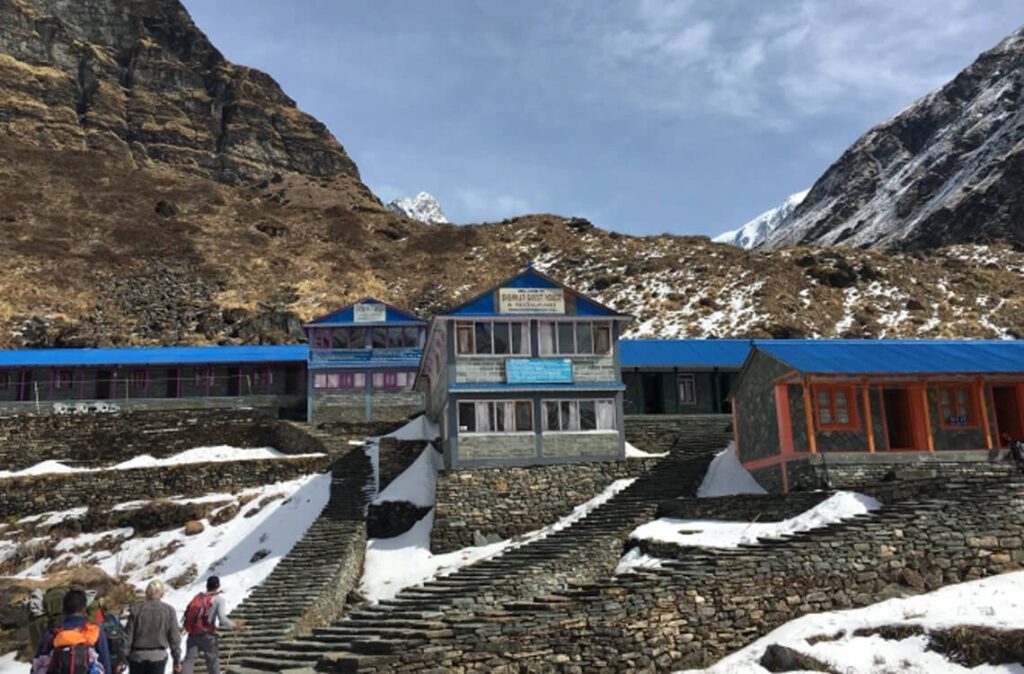
Machhapuchhre Base Camp to Annapurna Base Camp:
The final leg of the trek takes you to the Annapurna Base Camp, which is located at an altitude of 3,700 meters.

The trail takes you through the Annapurna Sanctuary and offers incredible views of the Annapurna massif.
Annapurna Base Camp to Bamboo:
The return journey takes you back through the same route, with stops at Dovan, Chomrong, and Bamboo.
Bamboo to Jhinu Danda:
From Bamboo, you’ll descend to the hot springs at Jhinu Danda, where you can relax and soothe your muscles after the trek.
Jhinu Danda to Nayapul:
The final leg of the trek takes you back to Nayapul, where you’ll catch a jeep or bus back to Pokhara.
The crowd in Annapurna Base Camp in February
The number of visitors to the Annapurna Base Camp in February can vary from year to year, but it is generally a less busy time than peak trekking seasons (October-November and March-April).
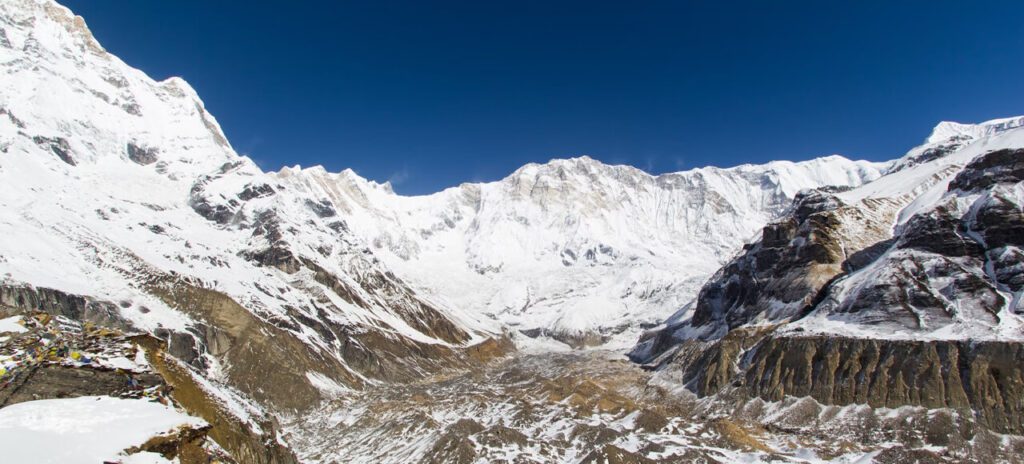
That being said, the popularity of the ABC trek has been increasing in recent years, so there may still be a significant number of trekkers at the base camp in February. However, it is unlikely to be as crowded as during peak season.
Highlights of Annapurna Base Camp in February
Here are some highlights of the Annapurna Base Camp Trek in February:
- Snowy Scenery: February is the winter season in Nepal and the Annapurna region experiences snowfall during this time. The entire trekking trail is covered in snow creating a breathtaking winter wonderland. The snow-capped mountains, frozen rivers, and forests of rhododendron and oak trees make for stunning views and photo opportunities. The trail may be a bit more challenging due to the snow but it’s worth it for the unique scenery.
- Fewer Crowds: February is considered a low season for trekking in Nepal. This means you’ll likely encounter fewer crowds on the trail allowing you to enjoy the peaceful surroundings and have more interaction with locals. You’ll also have more flexibility in terms of accommodation and can take your time to explore the villages and soak up the local culture.
- Culture and Festivals: February is an important month for both Hindu and Buddhist festivals in Nepal, and you may have the chance to witness these colorful and lively celebrations during your trek. One of the most popular festivals during this time is the Maha Shivaratri festival, which celebrates the Hindu god Shiva. It’s celebrated with music, dancing, and offerings at temples throughout the country. You may also witness the Tibetan New Year or Losar celebrations if you visit the villages with a significant Tibetan population.
- Hot Springs: After a long day of trekking in the snow, you can relax and soothe your muscles in the natural hot springs in Jhinu Danda. These hot springs are located on the banks of the Modi Khola River surrounded by beautiful scenery. The hot water is believed to have healing properties and is a popular spot for trekkers to unwind and rejuvenate.
Flora and Fauna
The trek takes you through a variety of terrains, from lush forests to high-altitude glaciers. Along the way, you’ll have the opportunity to see a wide range of flora and fauna.
Flora
In terms of flora, one of the most iconic plants in the Annapurna region is Rhododendron, Nepal’s national flower. These beautiful flowers bloom in February in the lower altitudes of the trek, adding a splash of color to the landscape.

In addition, you’ll see oak and pine trees in the lower altitudes of the trek which provide shade and shelter for the local wildlife. Bamboo is also common in the lower altitudes, especially near the Modi Khola River.
Fauna
When it comes to fauna there are several species that you may encounter on the Annapurna Base Camp trek. One of the most impressive is the Himalayan Tahr which is a type of mountain goat that is often seen in the higher altitudes of the trek. These animals are well adapted to life in the mountains with thick coats that protect them from the cold and hooves that allow them to climb steep slopes.
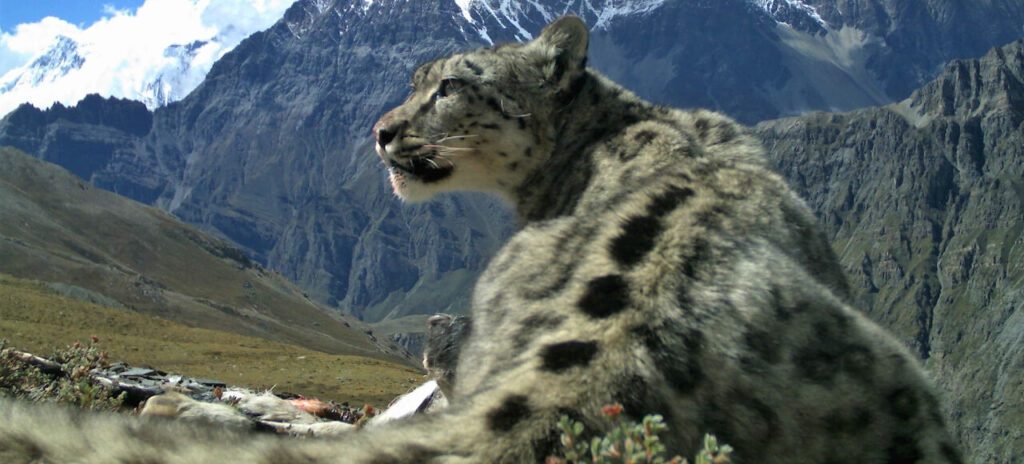
Another iconic animal of the Annapurna region is the Snow Leopard, a rare and elusive predator that is sometimes spotted in the higher altitudes of the trek. These animals are well camouflaged and prefer to hunt at night making them difficult to spot. However, if you’re lucky, you may catch a glimpse of one as it moves through the snowy terrain.
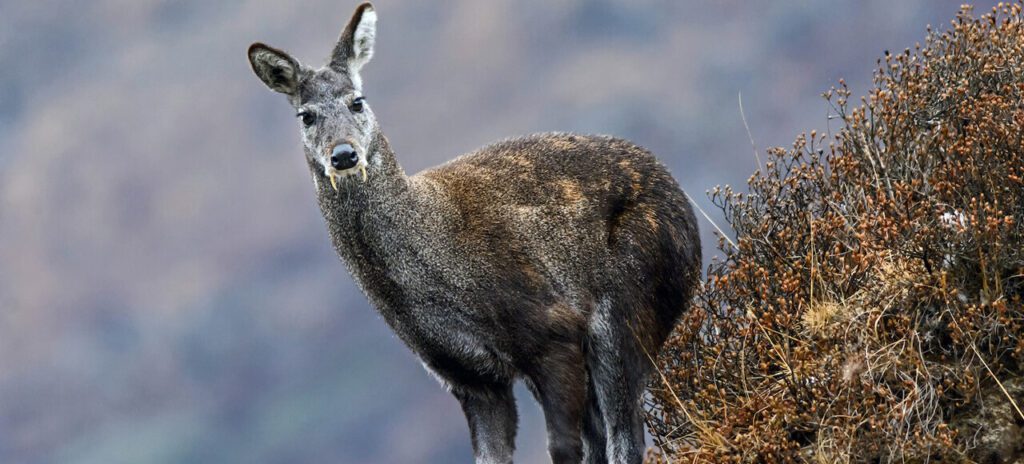
During your walk, you may encounter Langur monkeys and Musk Deer both of which inhabit the forests of the Annapurna region and are known for their distinct vocalizations.
Additionally, the higher elevations of the trek are home to the stunning Himalayan Monal, a popular bird species among birdwatchers due to its vibrant feathers.
Merits and Demerits
The Annapurna Base Camp Trek in February is an exciting adventure for trekkers who love snow and winter landscapes. However, there are both merits and demerits to consider before embarking on this journey.
Merits
- Fewer Crowds: One of the significant advantages of trekking in the off-season is that there are fewer people on the trail. During peak season months, the Annapurna region can get crowded, making it challenging to find accommodations and increasing the risk of altitude sickness. In February, the trails are less busy, allowing trekkers to enjoy the serenity of the mountains and connect with nature.
- Snowy Landscapes: Another benefit of trekking in February is the beautiful winter landscapes. The Annapurna region is already known for its breathtaking scenery, and the snow and ice make it even more picturesque. The frozen waterfalls, snow-capped mountains, and icy rivers create a unique and magical atmosphere that is not found during other times of the year.
- Lower Trekking Costs: As mentioned earlier, trekking in the off-season is generally less expensive. Accommodation and food prices are lower, and permits may be cheaper. This can make the trek more accessible to budget-conscious travelers.
- Cultural Experience: February is a great time to experience the local culture of the Annapurna region. The Gurung people celebrate their traditional festival Lhosar, during this time. Trekkers can witness the colorful festivities and learn more about the Gurung culture and customs.
Demerits
- Cold Weather: The most significant challenge of trekking in February is the cold weather. Temperatures at higher altitudes can drop well below freezing making it essential to have appropriate clothing and gear. Trekkers must have warm and waterproof clothing, sleeping bags, and a good-quality sleeping pad. It is also crucial to stay hydrated and fuel the body with warm food and drinks to keep the body warm.
- Difficult Terrain: Snow and ice can make the trail more challenging to navigate especially for inexperienced trekkers. The trail can be slippery making it essential to have proper footwear with good traction. Trekkers must be physically fit and mentally prepared for a challenging trek.
- Limited Accommodation and Facilities: Due to the off-season, some teahouses and lodges may be closed and others may have limited facilities. This can make finding accommodation and accessing hot showers, and electricity challenging. Trekkers must be prepared to rough it out and bring their own supplies.
- Flight Cancellations: Weather conditions in February can cause flight cancellations, making it difficult to reach the starting point of the trek. Trekkers should prepare for possible delays and cancellations and have a flexible itinerary that accounts for any unforeseen changes.
Doable Side Treks
There are several doable side treks that you can explore during the Annapurna Base Camp Trek in February. However, it’s important to note that February is still winter in Nepal and the higher elevations may be covered in snow. Therefore, it’s essential to be well-prepared and to check weather conditions before embarking on any side treks.
Here are some of the doable side treks in the Annapurna Base Camp Trek in February:
- Poon Hill: Poon Hill is a popular side trek that offers stunning views of the sunrise over the Himalayas. The trek takes about 4-5 hours from Ghorepani and can be done as a day trip from the base camp.
- Chhomrong Village: Chhomrong is a beautiful Gurung village that offers a glimpse of traditional Nepali life. The trek takes about 2-3 hours from the base camp and is relatively easy.
- Dovan: Dovan is a small village located on the way to the base camp. The trek takes about 3 to 4 hours from Bamboo and offers beautiful views of the Modi Khola River.
- Machhapuchhre Base Camp: It is located about 2-3 hours from the Annapurna Base Camp and offers views of the Mountain.
- Tadapani: Tadapani is a beautiful village located on the way to Ghorepani. The trek takes about 4-5 hours from Chhomrong and offers beautiful views of the Himalayas.
Please do note that these side treks can add additional days to your trek so be sure to plan accordingly and make sure you have enough time and supplies. Also, it’s always a good idea to hire a guide or porter to ensure your safety and to help navigate the trails.
Let our expert team at Asian Heritage Treks and Travel take care of everything — from guided tours to personalized packing tips and travel arrangements.
Plan My Annapurna Trip







